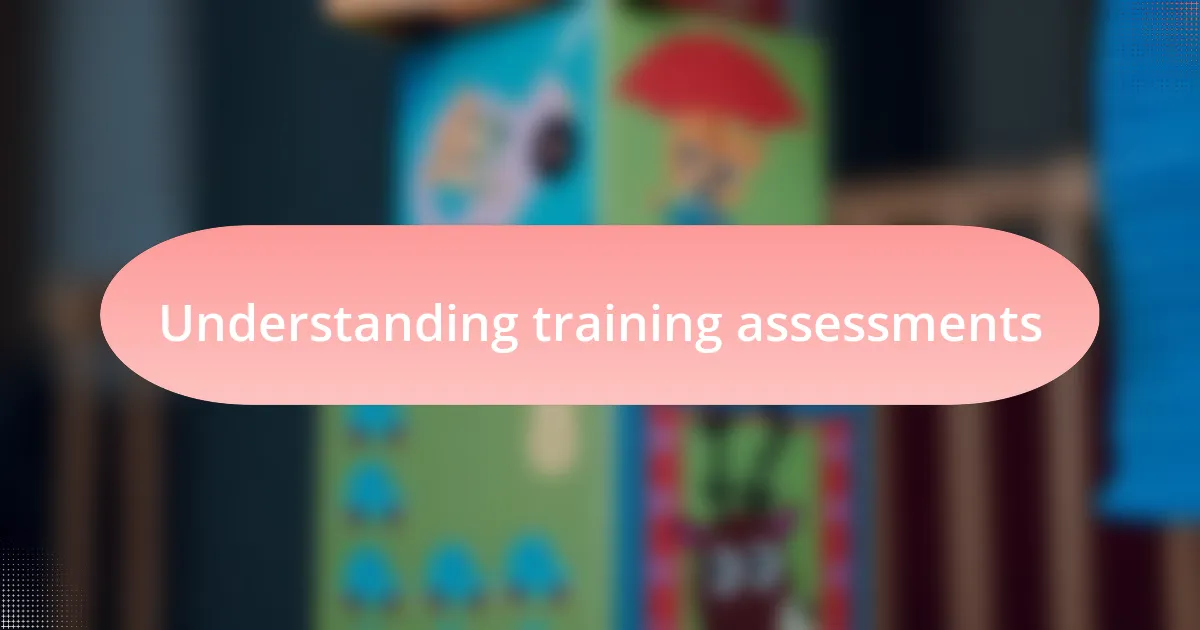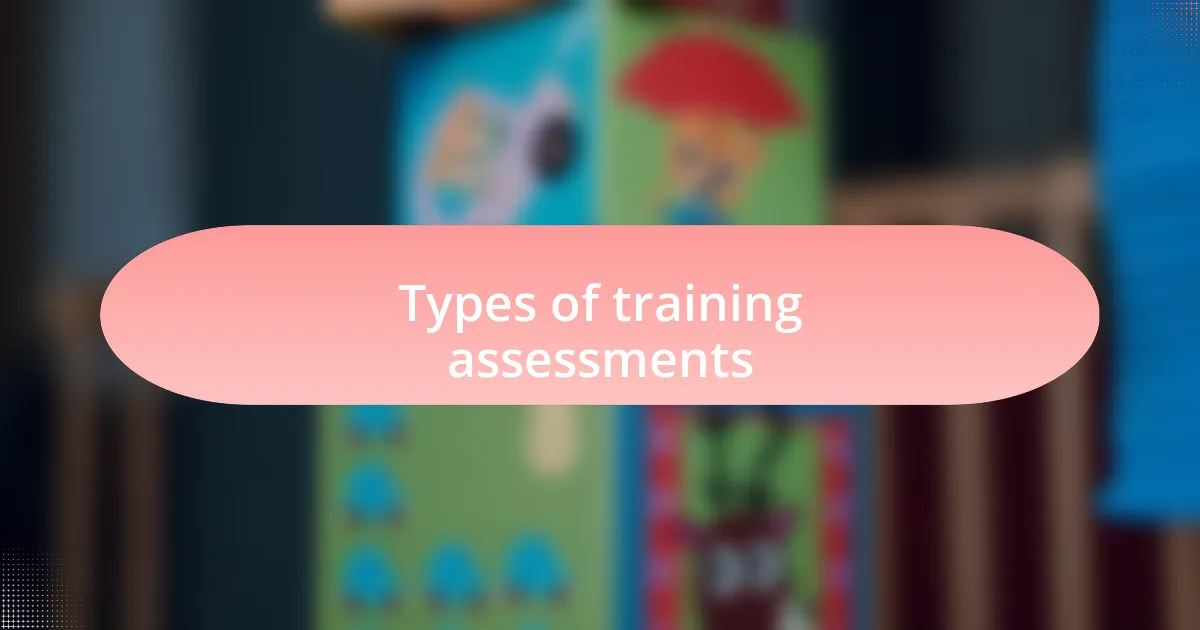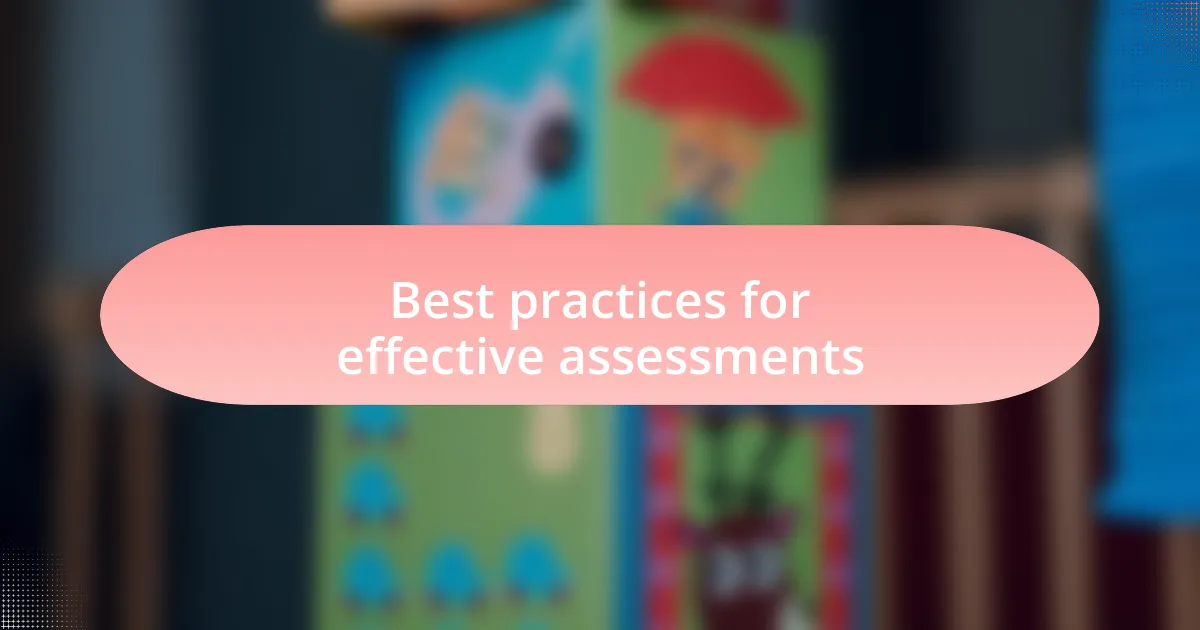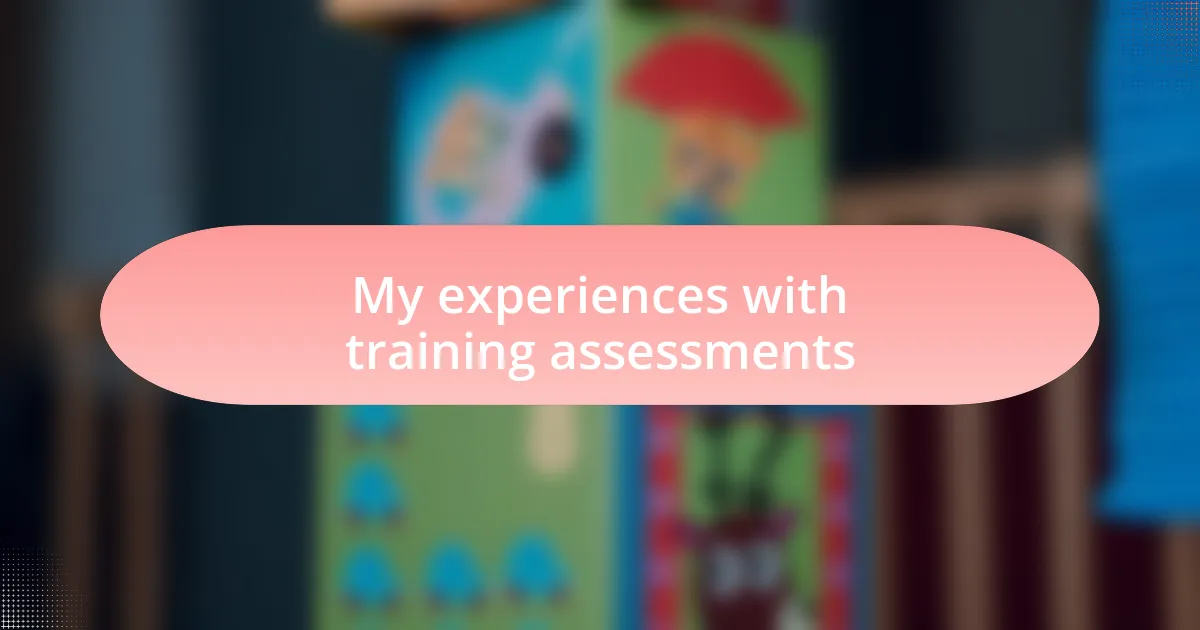Key takeaways:
- Training assessments bridge learning objectives with real-world applications, revealing knowledge gaps and fostering accountability.
- Utilizing diverse assessment types, such as formative, summative, and peer assessments, enhances engagement and understanding among participants.
- Best practices include setting clear objectives, using varied methods, and providing timely feedback to boost learner motivation and retention.
- Evaluating training outcomes requires a balance of quantitative metrics and qualitative insights, with attention to timing and stakeholder involvement for richer feedback.

Understanding training assessments
Training assessments serve as a critical bridge between learning objectives and real-world applications. I still remember my early days in corporate training when we first introduced assessments to gauge learner understanding. It was eye-opening to see how these assessments not only highlighted knowledge gaps but also illuminated paths for improvement.
Have you ever wondered how effective your training programs really are? Assessments provide that clarity, revealing what resonates with employees and what doesn’t. In one of my experiences, I discovered that a simple quiz after a session yielded invaluable feedback, demonstrating the importance of continual assessment in refining our educational approaches.
Furthermore, it’s essential to recognize that assessments are not merely a tool for evaluation; they foster a culture of accountability and growth. I’ve observed that when employees know they will be assessed, they tend to engage more deeply, seeing the training as a genuine investment in their professional journey. This perspective shift can make a significant difference in how individuals approach their learning experiences.

Types of training assessments
There are several types of training assessments that can be used to measure effectiveness and learning outcomes. For instance, formative assessments, such as quizzes and interactive activities during training sessions, provide real-time feedback. I recall a particular training workshop where we integrated quick polls. The instant results not only prompted discussions but also highlighted areas where participants felt uncertain.
Another key type is summative assessments, which occur at the end of a training program. They often include comprehensive tests or projects that assess employees’ mastery of the material. I once managed a project where we assigned a final presentation, allowing participants to showcase their learning creatively. Watching them present their thoughts was not just enlightening; it also represented the culmination of their efforts, sparking a sense of pride and achievement.
Finally, peer assessments, where colleagues evaluate one another’s performance, can foster collaboration and deeper understanding. I’ve found that this method encourages constructive feedback and nurtures a sense of community. Have you ever experienced the value of learning from a peer? It’s often in those moments of shared insight that I’ve seen the most significant growth and connection.

Best practices for effective assessments
When considering best practices for effective assessments, clarity in the assessment objectives is paramount. I remember once diving into a training initiative without clear goals, and it left participants puzzled about what was expected of them. Setting specific, measurable objectives not only guides the trainer but also helps participants focus on what they need to learn.
Using a variety of assessment methods caters to different learning styles and can deepen understanding. During a recent training session, we incorporated group discussions, individual quizzes, and hands-on activities. This approach kept everyone engaged and enabled me to see how diverse techniques helped in reinforcing concepts among participants. How often do you think about the mixed-method approach in your assessments? I’ve found it transforms the learning landscape significantly.
Lastly, timely feedback is crucial in the assessment process. I recall a participant from a recent program who thrived on instant feedback; it fueled her motivation and clarified misconceptions immediately. Can you imagine the difference it makes when learners understand how to improve right away? It not only boosts confidence but also enhances retention of the material.

My experiences with training assessments
My experiences with training assessments have often highlighted the importance of adaptability. I once facilitated a session where the assessment format I initially chose didn’t resonate with the participants. It was then I learned how crucial it is to be flexible and ready to pivot, tailoring assessments on the fly to better match the needs of the audience. Have you ever found yourself in a similar situation, wondering how to engage learners effectively?
Another memorable experience involved a peer feedback session after group projects. I could see how nervous everyone was at first, but as they began sharing insights, the atmosphere shifted. Witnessing participants provide constructive criticism and receive it positively was incredibly rewarding. It made me realize that fostering a safe space around assessments can significantly enhance collaboration and growth. Have you noticed how powerful peer feedback can be in developing critical thinking?
I also fondly remember an instance where we implemented self-assessment tools to empower learners to take ownership of their learning journeys. Seeing participants reflect on their progress not only deepened their understanding but also gave them a sense of agency. It struck me how self-assessment could lead to more meaningful learning experiences, prompting me to ask: how often do we encourage learners to evaluate themselves and their growth?

Lessons learned from training evaluations
Evaluating training outcomes has taught me that metrics alone don’t tell the whole story. I once conducted a follow-up survey after a leadership workshop, expecting numbers to drive my conclusions. However, the qualitative feedback revealed genuine personal growth and excitement among participants that numbers simply couldn’t capture. Have you ever been surprised by the emotional insights that can surface during evaluations?
Another lesson I learned was the significance of timing in assessments. I remember a situation where we gathered feedback immediately after a training session. While participants were eager to share, their fresh emotional responses often clouded their reflections. From that experience, I now advocate for a delayed feedback approach, allowing time for deeper insights to emerge. How might timing your evaluations impact the quality of the feedback you receive?
Lastly, I noticed how involving stakeholders in the evaluation process can lead to richer insights. During a project debrief, having both trainers and participants share their perspectives opened a dialogue that illuminated various facets of the training’s impact. It struck me that when everyone feels heard in the evaluation process, the outcomes become more comprehensive and actionable. How often do we create spaces for such candid discussions?